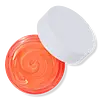What's inside
What's inside
 Key Ingredients
Key Ingredients

 Benefits
Benefits

 Concerns
Concerns

 Ingredients Side-by-side
Ingredients Side-by-side

Polybutene
Octyldodecanol
EmollientTrimethylolpropane Triisostearate
EmollientMicrocrystalline Wax
Emulsion StabilisingHydrogenated Poly(C6-14 Olefin)
EmollientHydrogenated Styrene/Isoprene Copolymer
Stearalkonium Hectorite
Gel FormingArgania Spinosa Kernel Oil
EmollientOlea Europaea Fruit Oil
MaskingRosa Canina Fruit Oil
EmollientRubus Idaeus Seed Oil
EmollientRubus Idaeus Leaf Extract
Skin ConditioningAroma
Dicalcium Phosphate
AbrasiveGlycerin
HumectantPropylene Carbonate
SolventCaprylic/Capric Triglyceride
MaskingPerlite
AbsorbentTocopherol
AntioxidantLimonene
PerfumingSodium Saccharin
MaskingPentaerythrityl Tetra-Di-T-Butyl Hydroxyhydrocinnamate
AntioxidantBenzyl Alcohol
PerfumingBenzyl Benzoate
AntimicrobialCI 77891
Cosmetic ColorantCI 15985
Cosmetic ColorantCI 15850
Cosmetic ColorantPolybutene, Octyldodecanol, Trimethylolpropane Triisostearate, Microcrystalline Wax, Hydrogenated Poly(C6-14 Olefin), Hydrogenated Styrene/Isoprene Copolymer, Stearalkonium Hectorite, Argania Spinosa Kernel Oil, Olea Europaea Fruit Oil, Rosa Canina Fruit Oil, Rubus Idaeus Seed Oil, Rubus Idaeus Leaf Extract, Aroma, Dicalcium Phosphate, Glycerin, Propylene Carbonate, Caprylic/Capric Triglyceride, Perlite, Tocopherol, Limonene, Sodium Saccharin, Pentaerythrityl Tetra-Di-T-Butyl Hydroxyhydrocinnamate, Benzyl Alcohol, Benzyl Benzoate, CI 77891, CI 15985, CI 15850
Bis-Diglyceryl Polyacyladipate-2
EmollientHydrogenated Polyisobutene
EmollientDiisostearyl Malate
EmollientButyrospermum Parkii Butter
Skin ConditioningSynthetic Wax
AbrasiveIsopropyl Palmitate
EmollientCetearyl Alcohol
EmollientCaprylic/Capric Triglyceride
MaskingActinidia Chinensis Seed Oil
EmollientAroma
Candelilla Cera
EmollientCaprylyl Glycol
EmollientCopernicia Cerifera Cera
EmollientCitric Acid
BufferingCitronellol
PerfumingCocos Nucifera Oil
MaskingGeraniol
PerfumingHelianthus Annuus Seed Oil
EmollientPersea Gratissima Oil
Skin ConditioningPolyurethane-79
Punica Granatum Sterols
Skin ConditioningStevioside
MaskingTocopherol
AntioxidantTocopheryl Acetate
AntioxidantTriethoxycaprylylsilane
CI 77891
Cosmetic ColorantBis-Diglyceryl Polyacyladipate-2, Hydrogenated Polyisobutene, Diisostearyl Malate, Butyrospermum Parkii Butter, Synthetic Wax, Isopropyl Palmitate, Cetearyl Alcohol, Caprylic/Capric Triglyceride, Actinidia Chinensis Seed Oil, Aroma, Candelilla Cera, Caprylyl Glycol, Copernicia Cerifera Cera, Citric Acid, Citronellol, Cocos Nucifera Oil, Geraniol, Helianthus Annuus Seed Oil, Persea Gratissima Oil, Polyurethane-79, Punica Granatum Sterols, Stevioside, Tocopherol, Tocopheryl Acetate, Triethoxycaprylylsilane, CI 77891
 Reviews
Reviews

Ingredients Explained
These ingredients are found in both products.
Ingredients higher up in an ingredient list are typically present in a larger amount.
Aroma refers to an ingredient, or mixture of ingredients, that impart or mask a flavor.
The name is slightly confusing. This is because INCI associates aroma with flavor instead of smell.
Here is the official definition from the The International Cosmetic Ingredient Dictionary and Handbook:
“Aroma is a term for ingredient labeling used to identify that a product contains a material or combination of materials normally added to a cosmetic to produce or to mask a particular flavor.”
INCI shows the only purpose of aroma to be "flavouring".
However, due to regulation differences, some companies may use aroma in place of parfum.
In Canada, this ingredient only has to be listed in concentrations above 1%.
Learn more about AromaThis ingredient is an emollient, solvent, and texture enhancer. It is considered a skin-softener by helping the skin prevent moisture loss.
It helps thicken a product's formula and makes it easier to spread by dissolving clumping compounds.
Caprylic Triglyceride is made by combining glycerin with coconut oil, forming a clear liquid.
While there is an assumption Caprylic Triglyceride can clog pores due to it being derived from coconut oil, there is no research supporting this.
Learn more about Caprylic/Capric TriglycerideCi 77891 is a white pigment from Titanium dioxide. It is naturally found in minerals such as rutile and ilmenite.
It's main function is to add a white color to cosmetics. It can also be mixed with other colors to create different shades.
Ci 77891 is commonly found in sunscreens due to its ability to block UV rays.
Learn more about CI 77891Tocopherol (also known as Vitamin E) is a common antioxidant used to help protect the skin from free-radicals and strengthen the skin barrier. It's also fat soluble - this means our skin is great at absorbing it.
Vitamin E also helps keep your natural skin lipids healthy. Your lipid skin barrier naturally consists of lipids, ceramides, and fatty acids. Vitamin E offers extra protection for your skin’s lipid barrier, keeping your skin healthy and nourished.
Another benefit is a bit of UV protection. Vitamin E helps reduce the damage caused by UVB rays. (It should not replace your sunscreen). Combining it with Vitamin C can decrease sunburned cells and hyperpigmentation after UV exposure.
You might have noticed Vitamin E + C often paired together. This is because it is great at stabilizing Vitamin C. Using the two together helps increase the effectiveness of both ingredients.
There are often claims that Vitamin E can reduce/prevent scarring, but these claims haven't been confirmed by scientific research.
Learn more about Tocopherol